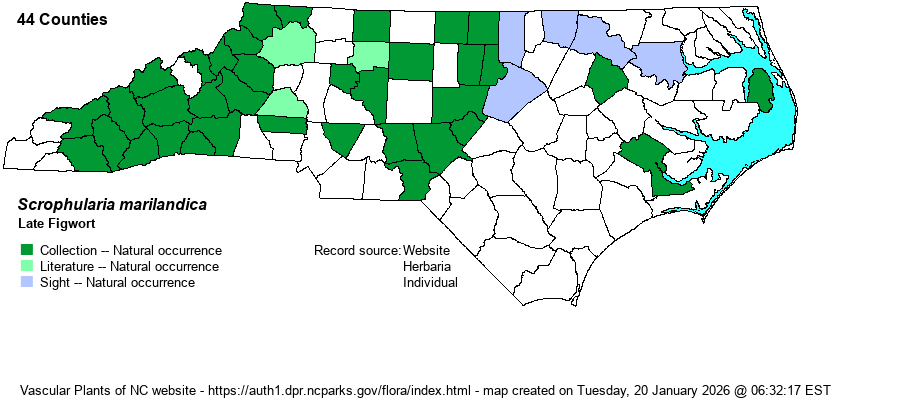| Author | L. | |
| Distribution | Present over nearly all of the Mountains, and widely scattered over nearly all of the Piedmont. Ranges sparingly into the northern half of the Coastal Plain, south to Craven County. Absent from the southern 40% of the Coastal Plain, including the Sandhills region.
This is a very widespread Eastern species. It ranges from New England and MN south to northern FL and barely to TX, though scarce in the Coastal Plain. | |
| Abundance | Fairly common to frequent in most of the Mountains, though rare in the extreme southwestern corner. Uncommon in the Piedmont, but probably rather rare in counties bordering SC; seems to be increasing in this province, as Cronquist and Oosting (1959) called it "Rare". This website map shows it occurring in nearly half of the counties in the province, with many of these recent observations. Very rare in the northern and central Coastal Plain. | |
| Habitat | This species prefers rich hardwood forests. In the Mountains it is found in Rich Cove Forests and other moist forests and in slight openings. In the Piedmont and Coastal Plain it is found mainly in Basic Mesic Forests. It can also be found in somewhat rich portions of Mesic Mixed Hardwood Forests, and occasionally along moist roadbanks and forest edges. |
| Phenology | Blooms from mid-July into October, and fruits shortly after blooming. The rather similar S. lanceolata blooms from May to early July and has finished blooming by the time this species begins. | |
| Identification | This is a fairly robust and tall species, growing to about 3-4 feet tall, often somewhat leaning. It has scattered opposite leaves, each on a long petiole about 1-inch in length. The leaf blade is ovate to ovate-lanceolate, about 4-5 inches long and about 2.5 inches wide, but with very small serrations (not readily visible from a few feet away). The leaf serrations in S. lanceolata are quite large, often 1/5-inch long or more. The top of the stem contains the wide open panicle, about 4-5 inches long and rather pyramid-shaped --- wider at the bottom than at the top. There are several dozen small flowers, each looking like a small preacher standing in a pulpit; in this species, the flower is dull greenish on the outside but purplish-brown on the inside. In S. lanceolata, the flowers are greenish on the outside, and paler on the inside, but not dark purple-brown. The "preacher" is actually a sterile filament, and it is also purplish-brown in this species, and it is yellow-green in S. lanceolata, the main floral difference between these two species. Thus, to separate these two, note that S. marilandica has very finely serrated leaves (each tooth less than 3 mm long), a pyramid-shaped panicle instead of more cylindrical, and a purple-brown sterile filament inside the cup of the flower. Also note that S. marilandica does not begin blooming in the state until at least mid-July, after S. lanceolata should be finished. | |
| Taxonomic Comments | None
| |
| Other Common Name(s) | Maryland Figwort, Carpenter's-square, Eastern Figwort | |
| State Rank | S3 [S4] | |
| Global Rank | G5 | |
| State Status | | |
| US Status | | |
| USACE-agcp | FACU link |
| USACE-emp | FACU link |

